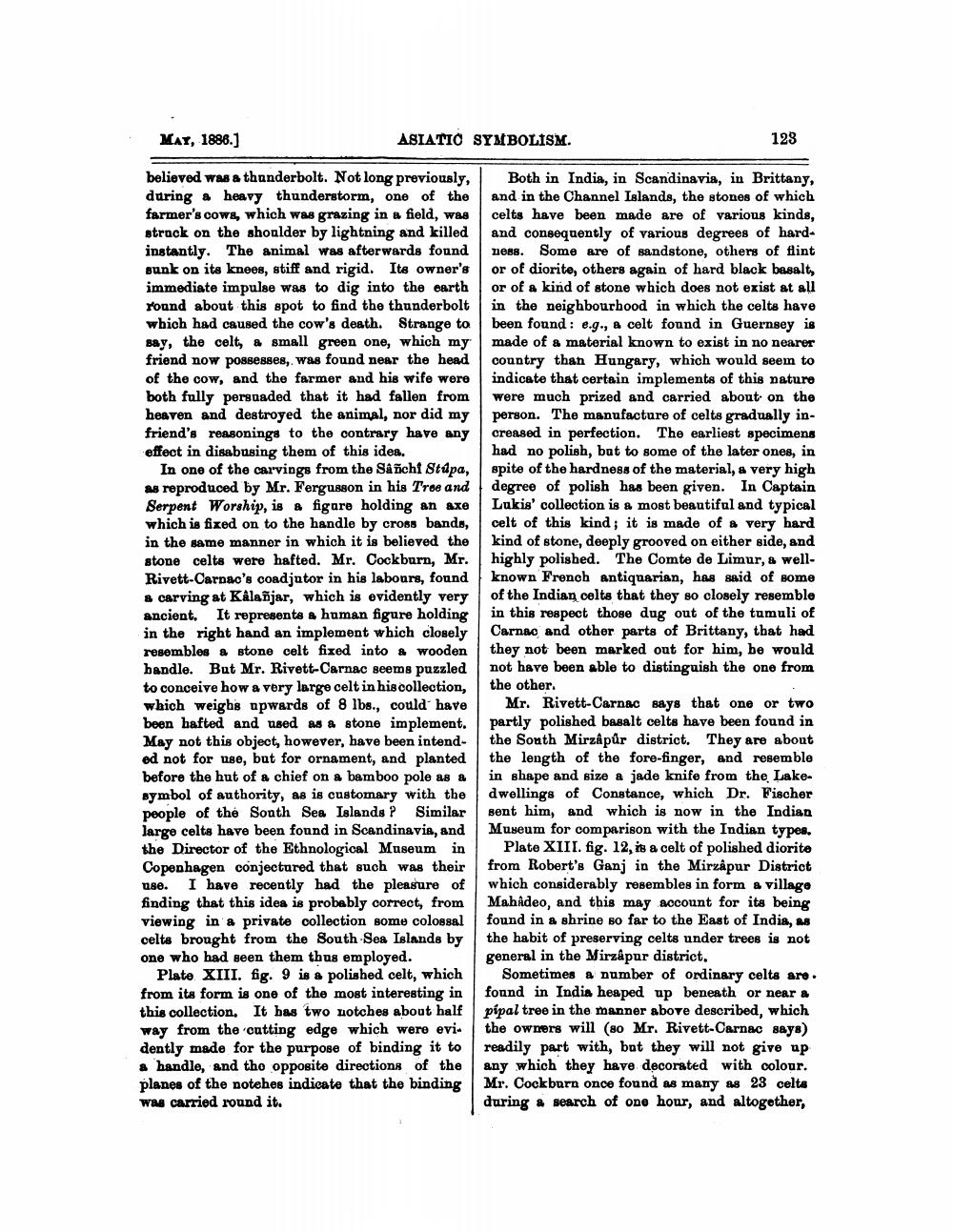________________
MAY, 1886.)
ASIATIO SYMBOLISM.
123
believed was a thunderbolt. Not long previously, during a heavy thunderstorm, one of the farmer's cows, which was grazing in a field, was strack on the shoulder by lightning and killed instantly. The animal was afterwards found sunk on its knees, stiff and rigid. Its owner's immediate impulse was to dig into the earth Yoand about this spot to find the thunderbolt which had caused the cow's death. Strange to Bay, the celt, a small green one, which my friend now possesses, was found near the head of the cow, and the farmer and his wife were both fully persuaded that it had fallen from heaven and destroyed the animal, nor did my friend's reasonings to the contrary have any effect in disabusing them of this idea.
In one of the carvings from the Sañchi Stupa, as reproduced by Mr. Fergusson in his Tres and Serpent Worship, is & figare holding an axe which is fixed on to the handle by cross bands, in the same manner in which it is believed the stone celts were hafted. Mr. Cockburn, Mr. Rivett-Carnao's coadjutor in his labours, found & carving at Kalañjar, which is evidently very ancient. It represents a human figure holding in the right hand an implement which closely resembles a stone celt fixed into a wooden handle. But Mr. Rivett-Carnac seems puzzled to conceive how a very large celt in his collection, which weighs opwards of 8 lbs., could have been hafted and used as a stone implement. May not this object, however, have been intend. ed not for use, but for ornament, and planted before the hut of a chief on a bamboo pole as a symbol of authority, as is customary with the people of the South Sea Islands P Similar large celts have been found in Scandinavia, and the Director of the Ethnological Museum in Copenhagen conjectured that such was their use. I have recently had the pleasure of finding that this idea is probably correct, from viewing in a private collection some colossal celts brought from the South Sea Islands by one who had seen them thus employed.
Plate XIII. fig. 9 is a polished celt, which from its form is one of the most interesting in this collection. It has two notches about half way from the cutting edge which were evidently made for the purpose of binding it to a handle, and tho opposite directions of the planes of the notehes indicate that the binding was carried round it.
Both in India, in Scandinavia, in Brittany, and in the Channel Islands, the stones of which celts have been made are of various kinds, and consequently of various degrees of hardtiens. Some are of sandstone, others of flint or of diorite, others again of hard black basalt, or of a kind of stone which does not exist at all in the neighbourhood in which the celts have been found : e.g., a celt found in Guernsey is made of a material known to exist in no nearer country than Hungary, which would seem to indicate that certain implements of this nature were much prized and carried about on the person. The manufacture of celts gradually increased in perfection. The earliest specimens had no polish, but to some of the later ones, in spite of the hardness of the material, a very high degree of polish has been given. In Captain Lukis' collection is a most beautiful and typical celt of this kind; it is made of a very hard kind of stone, deeply grooved on either side, and highly polished. The Comte de Limur, & wellknown French antiquarian, has said of some of the Indian celts that they so closely resemble in this respect those dug out of the tumuli of Carnac and other parts of Brittany, that had they not been marked out for him, be would not have been able to distinguish the one from the other.
Mr. Rivett-Carnac says that one or two partly polished basalt celts have been found in the South Mirzapur district. They are about the length of the fore-finger, and resemble in shape and size a jade knife from the Lakedwellings of Constance, which Dr. Fischer sent him, and which is now in the Indian Museum for comparison with the Indian types.
Plate XIII. fig. 12, is a celt of polished diorite from Robert's Ganj in the Mirzapur District which considerably resembles in form a village Mahadeo, and this may account for its being found in a shrine so far to the East of India, ms the habit of preserving celts under trees is not general in the Mirzapur district.
Sometimes a number of ordinary celts are. found in India heaped up beneath or near a pipal tree in the manner above described, which the owners will (80 Mr. Rivett-Carnac says) readily part with, but they will not give up any which they have decorated with colour. Mr. Cockburn once found as many as 23 celta during a search of one hour, and altogether,




